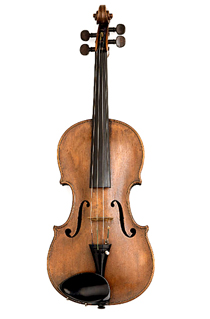DK Science: Musical Sound
Music is one of the glories of sound. When a musician plays a note of a certain pitch, the musical instrument vibrates or RESONATES and produces a complex pattern of sound waves made up of many different frequencies. The most noticeable sound wave is called the fundamental, but there are other waves with higher frequencies, called harmonics. Notes from a flute sound more pure than those from a saxophone because they contain fewer harmonics. Musical instruments often make very quiet sounds, but some are designed to AMPLIFY the sounds they make so we can hear them more easily.

A violin makes musical sounds when its strings vibrate. If you pluck a violin string and watch it closely, you can see it vibrating very quickly. The vibrations begin with the strings, but quickly make the large wooden body of the instrument vibrate as well. The vibrating body amplifies the sound greatly.

Hitting the two metal prongs of a tuning fork causes them to vibrate at a precise frequency. As they vibrate, they make the air around them vibrate, too. This produces sound waves in the form of a single, pure note. If you stand the base of the vibrating fork on a table, the table vibrates as well. This amplifies the note by making louder sound waves.

When you play any form of pipe instrument, such as a flute, the air inside vibrates in complex patterns. Sound waves come out and you hear them as musical notes. A long flute can make a long sound wave and a low-pitched note. A short piccolo makes shorter sound waves and higher notes. By blocking holes in a pipe with your fingers or by pressing keys, you can play notes of different pitch.

People compose music using sounds of different pitch. When musical sounds are arranged from low pitch to high pitch, they make a scale that can be written down on a staff. Each note on a scale is a sound of a different pitch. Different scales can be made by choosing different notes or by changing the way the pitch increases from one note to the next.

When you crash two cymbals together, the metal discs vibrate and make the air around them move. Cymbals vibrate in a more complex way than a tuning fork and make more of a noise than a musical note. A mixture of harmonics of different frequencies is created, and the sound wave that results is much more complex in shape than the wave of a tuning fork.
Resonance is the sound made by a vibrating object. If you tap a large wine glass, it produces a low musical note. If you tap a smaller glass, it makes a higher-pitched note. Although objects can vibrate at any frequency, each one has a particular frequency at which it vibrates much more powerfully. This is called its resonant frequency.
Opera singers can shatter a wineglass by singing a note that is exactly the same as the glass's resonant frequency. When the singer sings the note, the glass begins to vibrate and "sing" the same note itself. If the singer holds the note for several seconds, the vibrations become extremely powerful, shaking the glass until it smashes.
Making sounds louder is called amplification. Most musical instruments have a part that vibrates and makes sounds, and another part that makes the sounds louder (amplifies them). On their own, the vibrating parts may make quiet sounds that would be impossible to hear, even from nearby, if they were not increased in volume. Vibrating guitar strings are amplified either by a soundbox or by using electricity.

An acoustic guitar has a large wooden body, or soundbox, that amplifies the sounds made by the strings. As the strings vibrate, they make the body, to which they are attached, vibrate as well. The body is hollow and full of air. When it vibrates, the air inside it vibrates, too. This produces amplified, more intense sound waves that pass out through the hole in the front.
Under the steel strings of an electric guitar, there are tiny magnets that generate small amounts of electricity as the strings move. These currents are fed into a separate piece of equipment called an electronic amplifier. This increases the current many times and uses it to play the sound of the guitar through a loudspeaker.
